Recently, NITI Aayog released the report titled “India’s Blue Economy: Strategy for Harnessing Deep-Sea and Offshore Fisheries”.
- During the report launch, NITI Aayog hosted a workshop with 18 institutions, featuring state presentations on Deep-Sea Fisheries and Exports and a panel discussion on Resource Management and Regulatory Reforms.
Key Highlights of the NITI Aayog Report
- The report provides a comprehensive roadmap for tapping India’s underutilized deep-sea resources through a science-based, technology-driven, and ecologically sustainable framework — aligning with India’s Blue Economy Vision 2047.
- Framework for Deep-Sea Fisheries Development: The report proposes a science-based and inclusive model, integrating:
- Modern technology for deep-sea exploration and monitoring.
- Regional fisheries agreements for sustainable access to international waters.
- Social inclusion by empowering coastal and fisher communities.
- Six Core Policy Interventions:
-
- Regulatory Reforms: Overhaul of existing marine fisheries policies to ensure efficient governance of Exclusive Economic Zone (EEZ) activities.
- Institutional and Capacity Strengthening: Building research, training, and extension capacities at national and state levels.
- Fleet Modernization: Upgrading vessels with eco-friendly technology, navigation, and safety systems.
- Sustainable Management: Implementing real-time data collection, catch quotas, and marine biodiversity protection measures.
- Resource Mobilization: Blending public–private investments, Blue Bonds, and financial inclusion of cooperatives.
- Community Participation: Promoting fisher cooperatives and cluster-based fleet ownership for equitable benefit-sharing.
- Phased Implementation:
- Phase I (2025–28): Building institutional frameworks and pilot deep-sea ventures.
- Phase II (2029–32): Expanding capacity and achieving export competitiveness.
- Phase III (2033 onwards): Global leadership in sustainable deep-sea fisheries and technology innovation.
Significance of the Report
- Economic Empowerment: Harnessing deep-sea fisheries could increase seafood exports, generate employment, and reduce coastal fishing pressure, enhancing marine resource sustainability.
- Blue Economy Integration: Aligns with the Blue Economy Vision — leveraging marine resources for sustainable growth, livelihood, and ecological balance.
- Livelihood Security: Cluster-based fleet ownership ensures collective participation of small-scale fishers, bridging the gap between artisanal and industrial sectors.
- Environmental Sustainability: Adopts a precautionary, ecosystem-based approach to balance economic growth with biodiversity conservation.
- Strategic and Geopolitical Relevance: Developing capacity in India’s EEZ and high seas strengthens maritime security, food sovereignty, and regional influence in Indo-Pacific fisheries governance.
Offshore Fisheries: Expanding India’s Deep-Sea Frontier
- Definition and Scope: Offshore or deep-sea fisheries involve harvesting fish and marine organisms beyond the 12-nautical-mile territorial waters, extending up to India’s Exclusive Economic Zone (EEZ) of 2.4 million sq km, targeting under-exploited pelagic and mesopelagic resources.
- Rationale: Near-shore fishing grounds are over-exploited, making deep-sea expansion essential for resource diversification, export growth, and reducing pressure on coastal ecosystems.
- Resource Potential: Estimated annual yield of 1.2 million tonnes from tuna, mackerel, squids, and deep-water crustaceans, with major prospects in Lakshadweep, Andaman & Nicobar, and the Bay of Bengal Ridge.
- Technological Modernisation: Adoption of eco-friendly longliners, multi-day vessels, satellite-based navigation, fish-finding sonars, and on-board cold storage under fleet-modernisation drives ensures efficiency and product quality.
- Policy and Regulation: The proposed Deep-Sea Fisheries Policy 2025 and NITI Aayog’s roadmap recommend licensing frameworks, catch documentation, and real-time monitoring systems to regulate effort and ensure sustainability.
- Institutional Support: Establishment of a National Deep-Sea Fisheries Authority under the Department of Fisheries is envisaged for licensing, data collection, training, and inter-agency coordination.
- Economic and Social Impact: Offshore fisheries can generate 2–3 lakh direct jobs, enhance seafood exports by 15–20 %, and empower coastal cooperatives through cluster-based fleet ownership.
- Environmental Safeguards: Emphasis on ecosystem-based management, by-catch reduction devices, and seasonal moratoria to balance economic exploitation with biodiversity conservation.
About Blue Economy
- Definition: The Blue Economy refers to the sustainable use of ocean resources for economic growth, improved livelihoods, and ocean ecosystem health.
- Scope: It encompasses activities such as fisheries, aquaculture, renewable energy, marine biotechnology, shipping, coastal tourism, and seabed mining.
- Global Significance: The global Blue Economy is valued at over US$ 1.5 trillion annually and is projected to double by 2030.
- Core Principle: The Blue Economy approach stresses development without degradation, balancing economic efficiency with ecological sustainability.
- Global Significance: The global Blue Economy is valued at over US$ 1.5 trillion annually and is projected to double by 2030.
India’s Marine Wealth and Opportunity
- Coastline: 11,098 kilometres across 9 coastal states (Gujarat, Maharashtra, Goa, Karnataka, Kerala, Tamil Nadu, Andhra Pradesh, Odisha, and West Bengal) and 4 Union Territories (Daman and Diu, Puducherry, Andaman & Nicobar Islands, and Lakshadweep), offering enormous potential for fisheries, ports, and tourism.
- Exclusive Economic Zone (EEZ): Over 2.4 million square kilometres rich in fish stocks and mineral resources.
- Potential Marine Yield: Estimated at 7.16 million tonnes annually, combining conventional and deep-sea fisheries.
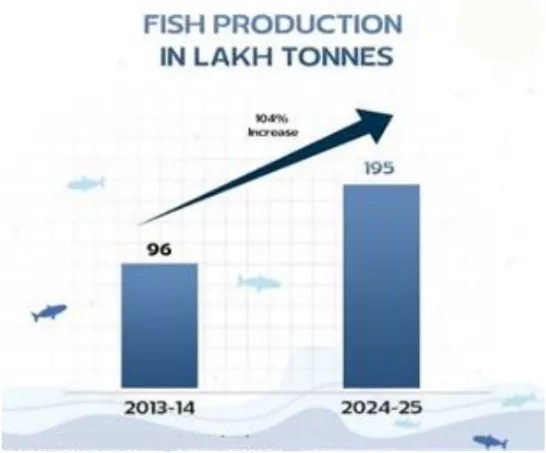 Employment Base: Supports 30 million livelihoods, especially in Andhra Pradesh, Gujarat, Kerala, Odisha, and Tamil Nadu.
Employment Base: Supports 30 million livelihoods, especially in Andhra Pradesh, Gujarat, Kerala, Odisha, and Tamil Nadu.- Global Standing: Second-largest fish producer globally, with 8% share in world production and major exporter of marine products.
India’s Fisheries Transformation Journey (2013–2025)
- India is the second-largest fish producer globally, contributing 8% of world output. The sector sustains over 30 million livelihoods, particularly in coastal and rural areas, while serving as a key source of nutrition, employment, and exports.
- Spectacular Growth: From 2013–14 to 2024–25, total fish production surged by 104%, rising from 96 lakh tonnes to 195 lakh tonnes.
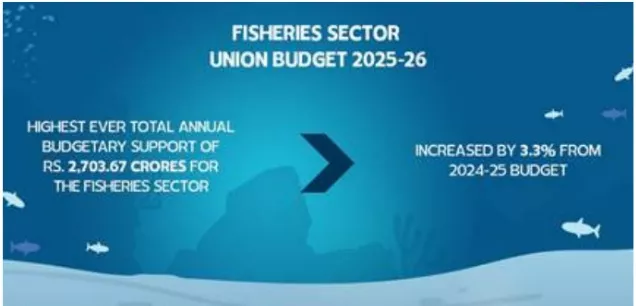 Inland fisheries recorded the highest expansion with a 142% increase (61 → 147.37 lakh tonnes), reflecting a shift toward modern, high-yield aquaculture.
Inland fisheries recorded the highest expansion with a 142% increase (61 → 147.37 lakh tonnes), reflecting a shift toward modern, high-yield aquaculture.- This transformation has been powered by technology adoption, cold-chain infrastructure, and integrated value chains, ensuring faster delivery, improved quality, and better market returns.
- Budgetary Milestone: The Union Budget 2025–26 allocated ₹2,703.67 crore, the highest-ever support for the fisheries sector, underscoring its strategic importance in India’s Blue Economy agenda.
Blueprint for a Sustainable Blue Economy by 2035
- Strategic Investment Focus: Prioritize high-impact sectors including fisheries, ports, coastal tourism, and offshore renewable energy. Develop a pipeline of feasible, ready-to-launch projects to attract targeted investment.
- Institutional Coordination: Establish a Blue Investment Helpdesk to guide investors through regulatory processes and fast-track approvals. Introduce annual progress dashboards to track key metrics such as project completion, job creation, and revenue generation.
- Sustainable Growth & Environmental Protection: Ensure all investments align with sustainability objectives, including net-zero emissions by 2070, marine ecosystem conservation, and climate change mitigation.
|
Key Components of India’s Blue Economy
- Fisheries and Aquaculture: Contributes around 1% to GDP and 5% to agricultural GDP.
- Deep-sea potential remains untapped, while coastal fisheries face overexploitation.
- Investment in cold chains, processing units, and stock assessment systems is crucial for efficiency.
- Maritime Transport and Shipping: India’s 13 major ports and 200+ minor ports handle about 95% of total trade by volume.
- Sagarmala Programme modernises ports and integrates them with Coastal Economic Zones (CEZs) to enhance logistics and trade efficiency.
- Offshore Energy: Targets 30 Gigawatts (GW) of offshore wind capacity by 2030 along Gujarat and Tamil Nadu coasts.
- Emerging sectors include blue hydrogen, carbon capture and storage (CCS), and tidal energy.
- Marine Tourism: Coastal states like Goa, Kerala, and Andaman & Nicobar Islands have potential for eco-tourism, cruise tourism, and water sports.
- Promoting sustainable tourism can balance economic benefits with ecosystem preservation.
- Marine Biotechnology: Focus on pharmaceuticals, nutraceuticals, biofuels, and biomaterials derived from marine biodiversity.
- Strengthened by investments in marine research and innovation clusters.
- Coastal Infrastructure and Community Development: Development of CEZs under Sagarmala and training programmes under Pradhan Mantri Matsya Sampada Yojana (PMMSY).
- Focuses on livelihood diversification, skill development, and climate-resilient housing for coastal populations.
Importance of the Blue Economy for India
- Economic Diversification: Reduces reliance on land-based sectors and opens up new revenue sources through fisheries, tourism, and renewable energy.
- Employment Generation: Provides livelihoods to millions in coastal communities, promoting inclusive growth and gender participation.
- Environmental Sustainability: Encourages Blue Carbon initiatives and Marine Protected Areas (MPAs) to conserve biodiversity and mitigate climate change.
- Strategic and Geopolitical Relevance: Enhances maritime security, trade connectivity, and regional cooperation under SAGAR.
- Support for Global Goals: Advances commitments under SDG 14 (Life Below Water), SDG 13 (Climate Action), and the Paris Agreement (2015).
- Scientific Advancement: Boosts marine research, biotechnology, and data-based ocean governance to ensure evidence-driven policymaking.
Indian Initiatives for Sustainable Blue Growth
- Foundations and Policy Evolution (2015–2020):
- Blue Revolution (2015): Marked the start of modern fisheries modernization focusing on productivity, aquaculture, and infrastructure development.
- Exposed gaps in post-harvest handling, traceability, and fisher welfare, leading to the next policy phase
- Fisheries & Aquaculture Infrastructure Development Fund (FIDF, 2018–26):
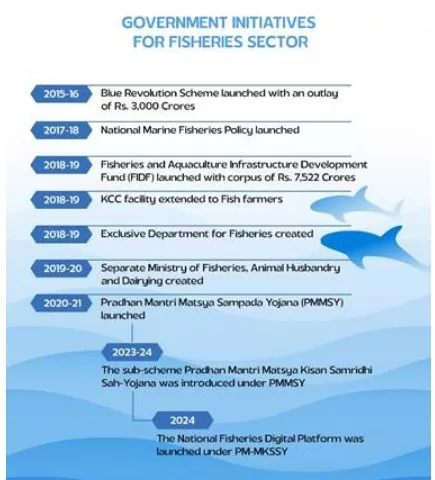 Corpus: ₹7,522.48 crore; interest subvention: 3%; credit guarantee: up to ₹12.5 crore.
Corpus: ₹7,522.48 crore; interest subvention: 3%; credit guarantee: up to ₹12.5 crore.- Nodal agency: National Fisheries Development Board (NFDB).
- Funds harbours, cold chains, and vessels; roadmap for 12,000 new cooperatives by 2033 (6,000 in Phase I: 2023–28).
- Flagship Programme – Pradhan Mantri Matsya Sampada Yojana (PMMSY, 2020–25):
- Objective: Create a modern, inclusive, and sustainable fisheries sector spanning seed to export.
- Total approved projects: ₹21,274.16 crore; Central share: ₹9,189.79 crore; ₹5,587.57 crore released.
- Infrastructure investments: ₹17,210.46 crore (Central ₹6,761.80 crore) for harbours, cold chains, processing, and logistics.
- Fish Farmer Producer Organisations (FFPOs): 2,000 existing cooperatives supported + 195 new FFPOs for aggregation and market power.
- Integrated Aquaparks: 11 sanctioned (₹682.60 crore) providing end-to-end aquaculture hubs—from seed to market.
- Start-up & MSME Support: 39 projects funded; ₹31.22 crore subsidy for entrepreneurship and innovation.
- Women-led Projects: ₹3,973.14 crore (2020–25) invested in women-centric aquaculture and processing units.
- Employment Impact: Generated large-scale jobs in farming, processing, transport, and marketing, transitioning India from subsistence to sustainable commercial fisheries.
- Financial and Digital Inclusion (2023–2027):
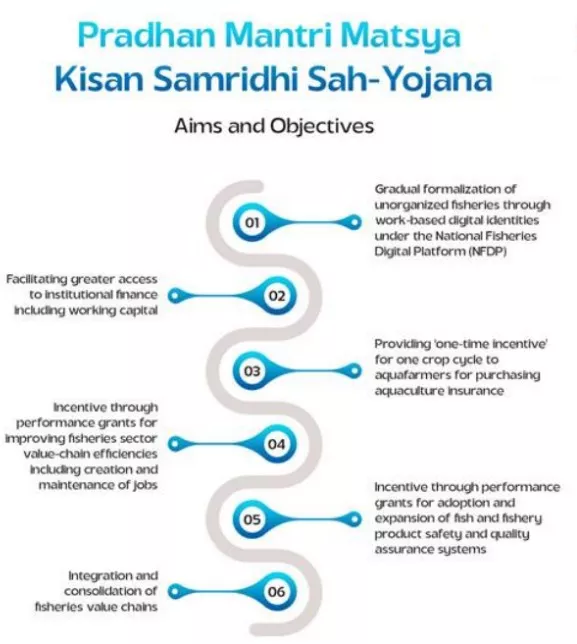 PM Matsya Kisan Samridhi Sah-Yojana (PM-MKSSY, 2023–27):
PM Matsya Kisan Samridhi Sah-Yojana (PM-MKSSY, 2023–27):
- Outlay: ₹6,000 crore (including ₹1,500 crore from World Bank & AFD, France).
- Promotes formalisation, insurance, credit access, traceability, and quality certification across the fisheries value chain.
- National Fisheries Digital Platform (NFDP, launched in Sept 2024):
- Serves as a single-window digital ecosystem under PM-MKSSY.
- Provides digital work IDs, institutional credit, aquaculture insurance, and performance-linked incentives.
- 26 lakh stakeholders registered (as of Aug 2025).
- Integrates training, data analytics, and beneficiary monitoring.
- Kisan Credit Card (KCC) for Fisheries:
- Credit limit: ₹5 lakh; 4.76 lakh KCCs issued (₹3,214.32 crore disbursed as of June 2025).
- Enhances financial resilience and working capital access for small-scale fishers.
- Technology and Sustainable Aquaculture:
- Resource-Efficient Systems:
- Recirculatory Aquaculture Systems (RAS): 12,000 units, ₹902.97 crore (Central ₹298.78 crore); water-saving and land-efficient.
- RAS is a high-density fish farming technology where water is continuously filtered, treated, and reused within the system, minimizing water intake and discharge.
- Biofloc Technology: 4,205 units, ₹523.30 crore (Central ₹180.04 crore); converts waste to feed, reducing water exchange.
- Biofloc Technology is a sustainable aquaculture system where beneficial microbes convert waste (mainly ammonia and organic matter) in water into protein-rich microbial biomass (“biofloc”), which serves as natural feed for fish or shrimp.
- Both promote circular “green aquaculture”, with higher yields and lower environmental footprint.
- Smart/Integrated Fishing Harbours:
- Developed at Vanakbara (Diu), Karaikal (Puducherry), and Jakhau (Gujarat) under ₹369.8 crore (60:40 Centre–State).
- Equipped with AI/IoT-based port management, online auctions, digital surveillance, renewables, and waste processing units.
- Fisheries Clusters:
- 34 clusters notified, including organic clusters in Sikkim and Meghalaya, focusing on branding, input quality, and market access.
- Marine Infrastructure, Trade, and International Cooperation:
- Blue Ports & International Partnerships (2025):
- FAO Technical Cooperation (March 2025) and AFD Eco-Fishing Ports Workshop (May 2025) launched.
- Aligns with FAO’s Blue Port Initiative, promoting AI-driven, eco-friendly harbours that integrate sustainability with competitiveness.
- Blue Economy Integration (Logistics & Trade):
- Sagarmala Programme: Links 13 major and 200+ minor ports moving 95% of India’s trade by volume.
- Promotes port-led industrialisation, Coastal Economic Zones (CEZs), and multimodal logistics.
- Coastal Livelihoods, Tourism, and Skill Development:
- Coastal & Cruise Tourism:
- States like Goa, Kerala, and the Andaman Islands are developing eco-tourism, mariculture, and cruise circuits with environmental safeguards.
- Promotes community-based livelihoods aligned with Blue Economy 2.0.
- National Blue Skills Programme:
- Aims to train 50,000 youth by 2028 in fisheries, logistics, and marine technology.
- Focuses on employability, digital literacy, and technical capacity for India’s expanding maritime sector.
Global Initiatives for Ocean Conservation and Sustainable Blue Economy
- London Convention (1972): Prevents marine pollution by controlling the dumping of wastes and other harmful substances into the oceans; promotes regional agreements for supplementary marine protection.
- Global Programme of Action (GPA, 1995): Protects marine environments from land-based sources of pollution, focusing on sustainable coastal and marine management practices.
- International Blue Carbon Initiative (2019): Aims to preserve and restore coastal ecosystems such as mangroves, seagrasses, and salt marshes to enhance carbon sequestration and combat climate change.
- GloLitter Partnerships Project (2019): Supports shipping and fisheries sectors in reducing plastic waste, promoting sustainable maritime practices and marine litter management.
- United Nations 30×30 Target (2020): Seeks to protect 30% of oceans and terrestrial ecosystems by 2030, advancing biodiversity conservation and climate resilience globally.
- Alliance for Blue Nature (2020): Promotes ocean conservation, marine biodiversity protection, and sustainable use of ocean resources through collaborative global efforts.
- International Blue Carbon Institute (2022): Focuses on research, conservation, and restoration of coastal blue carbon ecosystems to strengthen climate mitigation strategies.
Global Best Practices in Marine Conservation and Blue Economy
- Seychelles Blue Bonds: World’s first sovereign Blue Bond for financing marine conservation.
- Norway’s Integrated Ocean Management Plan: Combines fisheries, energy, and shipping for optimal ocean use.
- New Zealand: Recognised the Whanganui River as a legal entity under Māori stewardship, integrating cultural and ecological values.
- Indonesia’s “Building with Nature” Initiative: Uses mangroves and natural barriers to reduce coastal erosion.
- Japan’s Blue Carbon Programme: Promotes mangrove restoration for climate mitigation.
Enablers for Blue Economy Transformation
- Blue Financing: Adoption of Blue Bonds, Viability Gap Funding (VGF), and Public-Private Partnerships (PPPs) to attract private investment.
- Integrated Governance: Establishing an Inter-Ministerial Coordination Council on Blue Economy (IMCCBE) to streamline decision-making.
- Skill Development: Launching a National Blue Skills Programme to train 50,000 youth by 2028 in fisheries, logistics, and offshore energy.
- Research and Innovation: Creating a Blue Economy Research Hub for Marine Spatial Planning (MSP), blue carbon mapping, and ocean data analytics.
- Community Empowerment: Encouraging fisher cooperatives, women entrepreneurs, and local cluster-based approaches to ensure equity.
Challenges in India’s Blue Economy
- Fragmented Governance: Over 25 ministries and departments work in silos, delaying approvals and reducing efficiency.
- Technological Deficits: Limited access to multi-day fishing vessels, fish-finding equipment, and on-board cold-chain systems restricts deep-sea operations.
- Financial and Institutional Gaps: High capital costs, inadequate insurance, and absence of a dedicated Deep-Sea Fisheries Authority hinder expansion.
- Low Private Investment: Blue sectors contribute ~4% to GDP but attract less than 1% of infrastructure finance.
- Ecological and Regulatory Risks: Unregulated catch, by-catch mortality, and data deficiency on pelagic species threaten marine biodiversity.
- Marine plastic waste exceeds 0.6 million tonnes per year; 80% of coastal fish stocks are fully or overexploited.
- Sea-level rise of 3.3 mm/year, coral bleaching, and cyclonic disturbances threaten marine livelihoods.
- Gender Disparity: Women form 70% of post-harvest fisheries workforce, yet face wage gaps and low representation.
- Data Deficiency: Only 20% of the EEZ is scientifically mapped for resources and biodiversity.
- Skill and Safety Limitations: Poor training in deep-sea navigation and safety reduces participation of small fishers and cooperatives.
Way Forward
- Institutional and Policy Integration: Establish a National Blue Economy Authority or enact a Blue Economy Act to harmonise policies, ensure inter-ministerial coordination, and streamline governance across fisheries, maritime energy, and related sectors.
- Create a National Deep-Sea Fisheries Authority for unified licensing, monitoring, and capacity building.
- Technological Advancement and Data Governance: Deploy Artificial Intelligence (AI)-based vessel tracking, blockchain-based catch documentation, and on-board cold-chain facilities via Public–Private Partnerships (PPPs).
- Strengthen collaboration between the National Institute of Ocean Technology (NIOT) and the Indian National Centre for Ocean Information Services (INCOIS) for real-time ocean data integration, satellite mapping, and Marine Spatial Planning (MSP).
- Sustainable Resource and Climate Management: Implement catch quotas, seasonal moratoria, and by-catch reduction devices in line with Food and Agriculture Organization (FAO) guidelines.
- Promote mangrove restoration, coral reef regeneration, and seaweed carbon farming to enhance coastal resilience and meet India’s Nationally Determined Contributions (NDCs) and Net-Zero 2070 targets.
- Financial Inclusion and Sustainable Financing: Extend Blue Bonds, Kisan Credit Cards, Viability Gap Funding (VGF), and PPP financing to deep-sea fishers, ensuring risk coverage and accessible credit.
- Leverage the Green Climate Fund (GCF) and multilateral support for sustainable marine investments.
- Skill Development and Social Inclusion: Expand the National Blue Skills Programme for navigation, vessel maintenance, and marine safety.
- Empower women and tribal communities via eco-tourism, mariculture, ornamental fisheries, and coastal handicrafts, ensuring equitable participation and income diversification.
- Regional and Global Cooperation: Engage with Security and Growth for All in the Region (SAGAR) initiative, Indian Ocean Rim Association (IORA), Indo-Pacific Oceans Initiative (IPOI), and the United Nations (UN) Ocean Decade for shared governance, technology exchange, and capacity building.
Conclusion
India’s Blue Economy drives sustainable growth, ecological balance, and social inclusion, aligning with Article 48A (mandates the State to protect and improve the environment and safeguard forests and wildlife) and SDGs 14 (Life Below Water) and 13 (Climate Action) to ensure a resilient and environmentally secure maritime future.
![]() 15 Oct 2025
15 Oct 2025
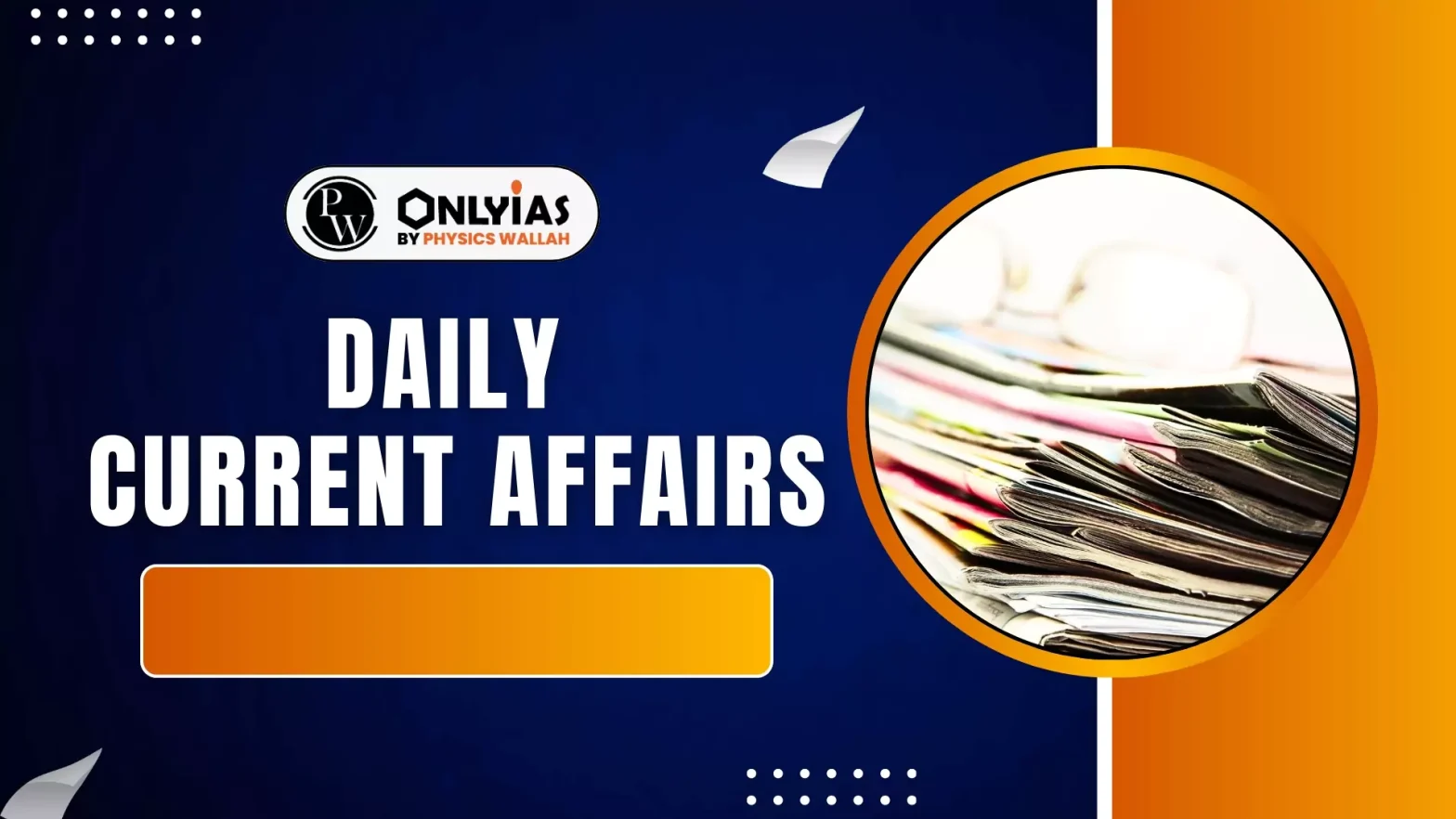
 Employment Base: Supports 30 million livelihoods, especially in Andhra Pradesh, Gujarat, Kerala, Odisha, and Tamil Nadu.
Employment Base: Supports 30 million livelihoods, especially in Andhra Pradesh, Gujarat, Kerala, Odisha, and Tamil Nadu. Inland fisheries recorded the highest expansion with a 142% increase (61 → 147.37 lakh tonnes), reflecting a shift toward modern, high-yield aquaculture.
Inland fisheries recorded the highest expansion with a 142% increase (61 → 147.37 lakh tonnes), reflecting a shift toward modern, high-yield aquaculture. Corpus: ₹7,522.48 crore; interest subvention: 3%; credit guarantee: up to ₹12.5 crore.
Corpus: ₹7,522.48 crore; interest subvention: 3%; credit guarantee: up to ₹12.5 crore. PM Matsya Kisan Samridhi Sah-Yojana (PM-MKSSY, 2023–27):
PM Matsya Kisan Samridhi Sah-Yojana (PM-MKSSY, 2023–27):

